
William Hooker Gillette was an American actor-manager, playwright, and stage-manager in the late 19th and early 20th centuries. He is best remembered for portraying Sherlock Holmes on stage and in a 1916 silent film.
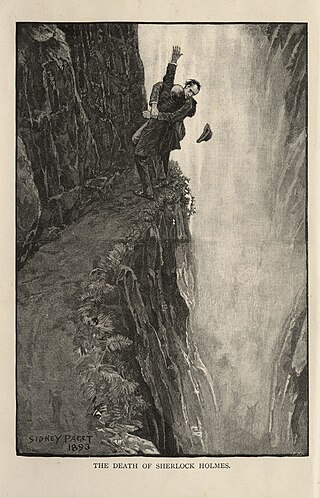
"The Final Problem" is a short story by Sir Arthur Conan Doyle featuring his detective character Sherlock Holmes. It was first published in The Strand Magazine in the United Kingdom, and McClure's in the United States, under the title "The Adventure of the Final Problem" in December 1893. It appears in book form as part of the collection The Memoirs of Sherlock Holmes.
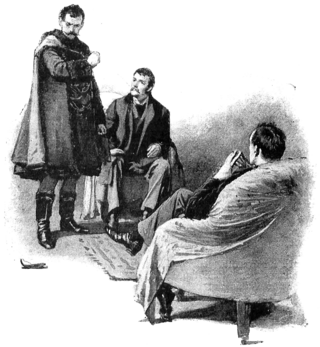
"A Scandal in Bohemia" is the first short story, and the third overall work, featuring Arthur Conan Doyle's fictional detective Sherlock Holmes. It is the first of the 56 Holmes short stories written by Doyle and the first of 38 Sherlock Holmes works illustrated by Sidney Paget. The story is notable for introducing the character of Irene Adler, who is one of the most notable female characters in the Sherlock Holmes series, despite appearing in only one story. Doyle ranked "A Scandal in Bohemia" fifth in his list of his twelve favourite Holmes stories.
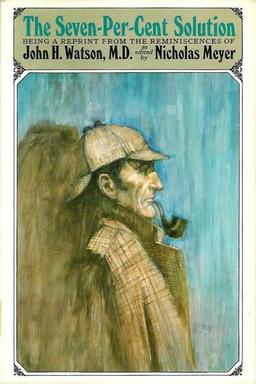
The Seven-Per-Cent Solution: Being a Reprint from the Reminiscences of John H. Watson, M.D. is a 1974 novel by American writer Nicholas Meyer. It is written as a pastiche of a Sherlock Holmes adventure, and was made into a film of the same name in 1976.
The stories of Sherlock Holmes by Sir Arthur Conan Doyle have been very popular as adaptations for the stage, and later film, and still later television. The four volumes of the Universal Sherlock Holmes (1995) compiled by Ronald B. De Waal lists over 25,000 Holmes-related productions and products. They include the original writings, "together with the translations of these tales into sixty-three languages, plus Braille and shorthand, the writings about the Writings or higher criticism, writings about Sherlockians and their societies, memorials and memorabilia, games, puzzles and quizzes, phonograph records, audio and video tapes, compact discs, laser discs, ballets, films, musicals, operettas, oratorios, plays, radio and television programs, parodies and pastiches, children's books, cartoons, comics, and a multitude of other items — from advertisements to wine — that have accumulated throughout the world on the two most famous characters in literature."

The Adventures of Sherlock Holmes is a 1939 American mystery adventure film based on Sir Arthur Conan Doyle's Sherlock Holmes detective stories. Although claiming to be an adaptation of the 1899 play Sherlock Holmes by William Gillette, the film bears little resemblance to the play.
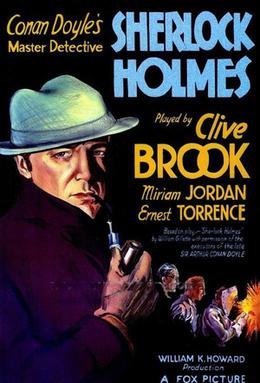
Sherlock Holmes is a 1932 American pre-Code film starring Clive Brook as the eponymous London detective. The movie is based on the successful stage play Sherlock Holmes by William Gillette, in turn based on the stories by Arthur Conan Doyle, and is directed by William K. Howard for the Fox Film Corporation. Brook had played Holmes previously in The Return of Sherlock Holmes and the "Murder Will Out" segment of Paramount on Parade.
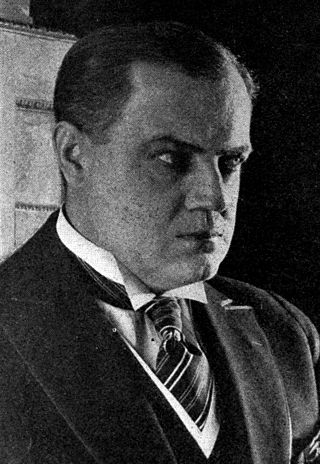
Anders Randolf was a Danish American actor in American films from 1913 to 1930.

Sherlock Holmes Baffled is an American silent trick film created in 1900 with cinematography by Arthur Marvin. It is the earliest known film to feature Arthur Conan Doyle's detective character Sherlock Holmes, albeit in a form unlike that of later screen incarnations. In the film, a thief who can appear and disappear at will steals a sack of items from Sherlock Holmes. At each point, Holmes's attempts to thwart the intruder end in failure.
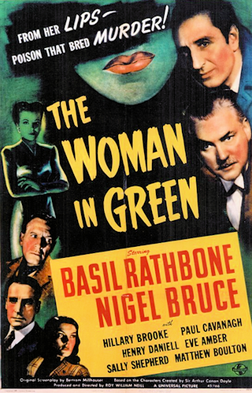
The Woman in Green is a 1945 American film, the eleventh of the fourteen Sherlock Holmes films based on the characters created by Arthur Conan Doyle. Produced and directed by Roy William Neill, it stars Basil Rathbone as Sherlock Holmes and Nigel Bruce as Dr. Watson, with Hillary Brooke as the woman of the title and Henry Daniell as Professor Moriarty. The film follows an original premise with material taken from "The Final Problem" (1893) and "The Adventure of the Cardboard Box.

Sherlock Holmes and the Secret Weapon (1942) is the fourth in the Basil Rathbone/Nigel Bruce series of 14 Sherlock Holmes films which updated the characters created by Sir Arthur Conan Doyle to the then present day. The film is credited as an adaptation of Conan Doyle's 1903 short story "The Adventure of the Dancing Men," though the only element from the source material is the dancing men code. Rather, it is a spy film taking place on the background of the then ongoing Second World War with an original premise. The film concerns the kidnapping of a Swiss scientist by their nemesis Professor Moriarty, to steal a new bomb sight and sell it to Nazi Germany. Sherlock Holmes and Dr. John Watson have to crack a secret code in order to save the country.
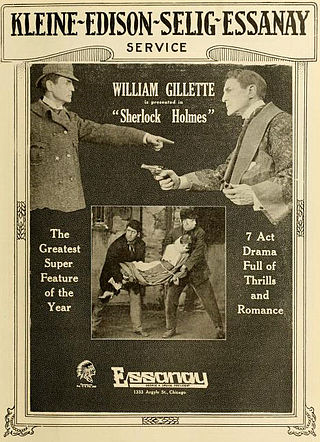
Sherlock Holmes is a 1916 American silent film starring William Gillette as Arthur Conan Doyle's Sherlock Holmes. Directed by Arthur Berthelet, it was produced by Essanay Studios in Chicago. The screenplay was adapted from the 1899 stage play of the same name, which in turn was based on the stories, "A Scandal in Bohemia," "The Final Problem," and A Study in Scarlet by Arthur Conan Doyle.

Gustav von Seyffertitz was a German film actor and director. He settled in the United States. He was born in Haimhausen, Bavaria, and died in Los Angeles, California, aged 81.
This article describes minor characters from the Sherlock Holmes stories by Sir Arthur Conan Doyle, and from non-canonical derived works. The list excludes the titular character as well as Dr. Watson, Professor Moriarty, Inspector Lestrade, Mycroft Holmes, Mrs. Hudson, Irene Adler, Colonel Moran, the Baker Street Irregulars, and characters not significant enough to mention.

The Hound of the Baskervilles is a 1937 German mystery film directed by Carl Lamac and starring Peter Voss, Fritz Odemar and Fritz Rasp. It is an adaptation of the 1902 Sherlock Holmes story The Hound of the Baskervilles by Arthur Conan Doyle. It was shot at the Babelsberg Studios in Potsdam and on location at the neo-Gothic Moyland Castle. The film's sets were designed by the art directors Wilhelm Depenau and Karl Vollbrecht.

The Hound of the Baskervilles is a 1921 British silent mystery film directed by Maurice Elvey and starring Eille Norwood, Catina Campbell and Rex McDougall. It is based on the 1902 Sherlock Holmes novel The Hound of the Baskervilles by Arthur Conan Doyle. It was made by Stoll Pictures, Britain's largest film company at the time. It was the first British film adaptation of the famous novel.
The Valley of Fear is a British silent adventure film of 1916 directed by Alexander Butler and starring Harry Arthur Saintsbury, Daisy Burrell and Booth Conway. The film is an adaptation of the 1915 novel, The Valley of Fear by Arthur Conan Doyle featuring Sherlock Holmes. This is now considered a lost film.

Sherlock Holmes is a four-act play by William Gillette and Sir Arthur Conan Doyle, based on Conan Doyle's character Sherlock Holmes. After three previews it premiered on Broadway November 6, 1899, at the Garrick Theatre in New York City.
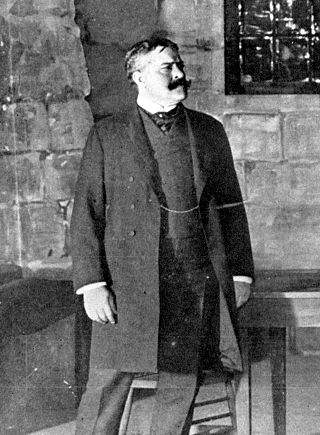
Professor James Moriarty is the fictional archenemy of Sherlock Holmes in some of the stories written by Sir Arthur Conan Doyle. He has appeared in several forms outside of the original stories.
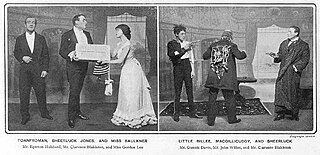
Sheerluck Jones, or Why D'Gillette Him Off is a burlesque on the popular 1899 play Sherlock Holmes. The comedy starred Clarence Blakiston as Sheerluck Jones and ran at Terry's Theatre (1901-02) for 138 performances.



















